#8KAIUpscaling
Explore tagged Tumblr posts
Photo

Details of old memories come to life in 8K. Samsung presents 2020 QLED 8K, the TV that changes everything. Find out more at: https://bit.ly/38niXVQ #QLED8K #8KAIupscaling #Samsungtv #tvshowroomatchennai #tvstoreinchennai #tvshopinadyar #TVForfamily #tvstoreinadyar #tvshowroominadyar #tvshopatchennai #homeappliancesstorenearme #homeappliancesshopadyar #homeappliancesshowroomnearme #tvstoreatchennai #homeapplianceshopnearme #householdapplianceshopadyar #householdappliancestoreadyar #householdappliancesshowroomatadyar #consumerdevices #ConsumerElectronics2020 #consumerelectronicshopadyar #consumerelectronicsshop #consumerelectronics2020store #consumerelectronicsstore #qled8kshop #qled8kstore #qled8ktv #qled8ksamsung #qled8ktv2020 #buyqled8ktvatbestprice (at Chennai, India) https://www.instagram.com/p/CECDCzSjnsP/?igshid=939dcu5p80oy
#qled8k#8kaiupscaling#samsungtv#tvshowroomatchennai#tvstoreinchennai#tvshopinadyar#tvforfamily#tvstoreinadyar#tvshowroominadyar#tvshopatchennai#homeappliancesstorenearme#homeappliancesshopadyar#homeappliancesshowroomnearme#tvstoreatchennai#homeapplianceshopnearme#householdapplianceshopadyar#householdappliancestoreadyar#householdappliancesshowroomatadyar#consumerdevices#consumerelectronics2020#consumerelectronicshopadyar#consumerelectronicsshop#consumerelectronics2020store#consumerelectronicsstore#qled8kshop#qled8kstore#qled8ktv#qled8ksamsung#qled8ktv2020#buyqled8ktvatbestprice
0 notes
Text
Overview of 8K AI Upscaling Technology
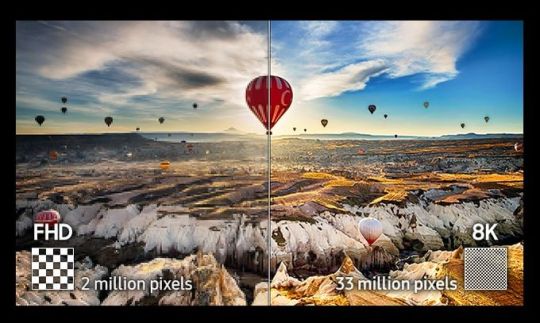
Experts have not yet finished arguing about the prospects for 4K TVs, but companies are already actively offering 8K models. Basically, skeptics of this trend use two fairly convincing arguments.
Introduction
First, many have not forgotten the relatively recent history of 3D TVs. The rapid growth of its popularity began after a demonstration at CES and IFA in 2010. Many experts quite logically predicted its excellent prospects. Unfortunately, the high cost of producing 3D content has become an insurmountable obstacle to its further development. As a result, almost all companies abandoned 3D support in their TVs. The second argument is based on the eye capabilities. Unfortunately, its maximum sharpness is significantly inferior, for example, to eagle vision. Of course, it would never occur to anyone to watch a 75-inch TV from a distance of, for example, up to 1 meter. But at a more adequate distance, the sharpness of our vision does not allow us to distinguish individual pixels smaller than a certain size. That is, vision does not perceive the difference between, for example, Full HD and 4K TVs with the same screen size. Perhaps the owners of a falcon or an eagle will be able to please their pets with a high-quality image, but they themselves will not see the difference. But these arguments have counterarguments. For example, companies are actively improving 8K AI upscaling technology.
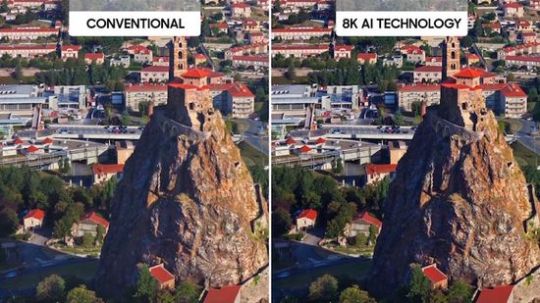
At a minimum, 8K TVs with AI upscaling will provide better quality playback of lower resolution content. In addition, the results of experiments open up some new aspects. In particular, South Korean scientists have studied the effect of vernier acuity (hyperacuity) to image formation by our brain. Their results allowed scientists to hypothesize that the brain is less tired when perceiving content with high resolution. At the same time, it watching provides richer emotions due to high realism of the perceived content.
Resolution
Of course, any TV provides maximum playback quality for corresponding native content in pixel-to-pixel mode. Unfortunately, the real situation on the market is often different from the ideal. For example, the capabilities of modern TVs often significantly exceed the resolution of the content offered. But sometimes devices, on the contrary, do not support content resolution. Of course, companies solve this problem. Modern algorithms use several basic technologies. The simplest of them increases the image resolution, replacing each pixel with four copies of it. Bilinear interpolation is more efficient. These algorithms compare the missing pixel with the two nearest ones, forming a linear gradient to sharpen the image.

Even more efficient bicubic interpolation uses 16 closest points in all directions, increasing color accuracy. Unfortunately, it often provokes a halo effect.
Main methods
A list of the most popular modern methods includes supersampling, checkerboard rendering and upscaling. Supersampling is a spatial anti-aliasing method for removing the aliasing in the rendered images. In fact, it first renders the image in 4K, and then displays it in 1080p resolution. As a result, the detail of the final image increases. Of course, rendering requires sufficient processing power. The Insects screenshot from Microsoft on Full HD TV demonstrates this effect.


Checkerboard Rendering reduces computing power requirements. In particular, it removes every second pixel and forms an image from the rest. The diagrams show the differences between Standard Rendering and Checkerboard Rendering.
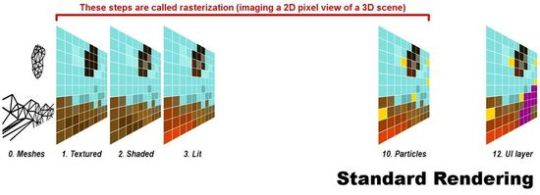
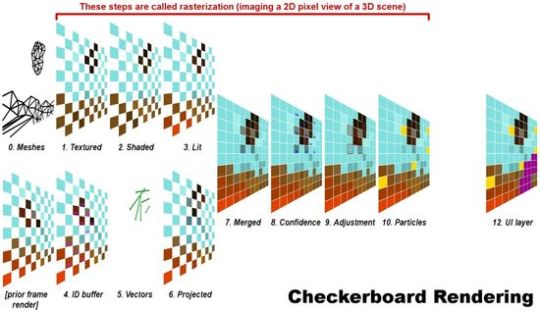
Removing pixels slightly reduces the image resolution, but significantly reduces the amount of computation. In fact, upscaling only resizes while maintaining its proportions. It can be considered the simplest method of converting image resolution. In this case, the TV processor forms additional pixels, providing the required resolution. Accordingly, the final image is a set of new averaged pixels.
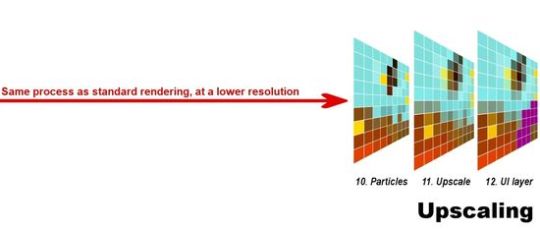
Unfortunately, the final image comparison demonstrates a significant decrease in quality compared to native content.
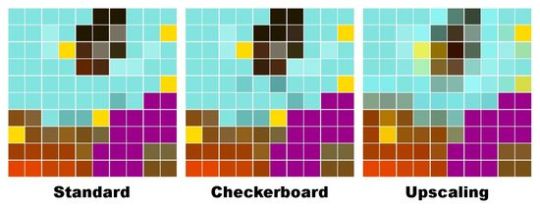
Upscaling
A few years ago, Samsung was the first to use the marketing term UHD Upscaling. Strictly speaking, almost any smartphone or computer has long supported this feature. Of course, its quality directly depends on the content. For example, the quality of SD - UHD Upscaling is significantly lower compared to Full HD - UHD Upscaling due to the insufficient number of pixels in the original image. The picture illustrates the difference in quality between SD / HD / Full HD - 4K Upscaling.
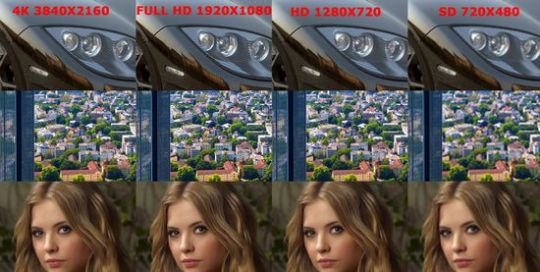
But its visualization is almost disappearing for Full HD. The first 4K TVs did not have an AI processor and simply scaled the image to the entire screen area using traditional interpolation and increasing the pixels size. Unfortunately, bilinear interpolation provides a fairly low quality due to loss of information, reduced detail, blurring outlines of objects, noise, etc. Moreover, mutual influence complicates their elimination. For example, sharpening increases noise, and conversely, reducing noise reduces detail. But companies have improved technology by developing AI Upscaling. Using a powerful high-performance processor radically improved upscaling quality. Today, almost all leaders use 8K AI Upscaling technology under different names. But, of course, they all use the same principles. Samsung is one of the leaders in the development of this technology. The company uses the powerful 8K Quantum processor, optimized for neural networks and AI processing. Samsung's MLSR (Machine Learning Super Resolution) technology uses machine learning, object recognition algorithms, and software filters.
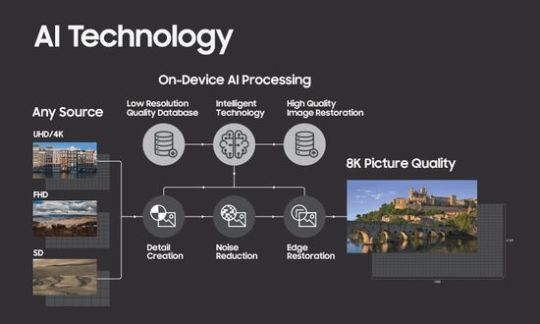
Samsung AI Upscaling
Simplified, this technology uses a constantly updated database of the images pairs in high and low resolution. It's formed as follows. The system selects an 8K image and lowers its resolution, adding noise and reducing the clarity of outlines. In addition, it performs several compression/decompression cycles with different quality levels to add characteristic artifacts. Generated images pairs of different quality are divided into classes, processed by algorithms based on neural networks and stored in a database. Subsequently, the processor analyzes the low-resolution image, finds the corresponding algorithm in the database with filters, and replaces it with an 8K pattern. In fact, the 8K AI Upscaling technology generates an image by analogy with the creation of Frankenstein from 8K patterns in the database. During processing, AI analyzes image fragments up to 60 times per second, correcting saturation, detail and white balance. CPU uses code lines of patterns base for localization of processing fragments. Such an algorithm increases the recognition accuracy of displayed objects. As a result, the processor almost accurately distinguishes, for example, the sky from its reflection in the windows. Moreover, the technology works quite well even with streaming video. But cloud computing for such content is not possible. Previously, AI machine learning used a formula bank, which is downloaded to the TV and updated periodically. But new Samsung Q950TS supports innovative Deep Learning using a neural network to expand machine learning. In fact, it creates its own formulas and algorithms, using processor-integrated basic training coefficients. Of course, Deep Learning has become a quality leap in AI processing. It is performed on a per-pixel basis with the use of noise reduction, restoration of contours, texture creation and restoration of small details. Deep Learning is primarily intended for small details and complex images.
Sony and LG 8K AI Upscaling
Sony's 8K AI Upscaling use dual database processing.

The first database recognizes compression noise, compares it with the patterns and eliminates artifacts. The second database increases resolution based on patterns. All new LG TVs use AI 8K Upscaling with new powerful α (Alpha) 9 Gen 3 AI processor with AI Deep Learning algorithms. In addition, it supports AI Picture Pro, AI Brightness and AI Sound Pro technologies.
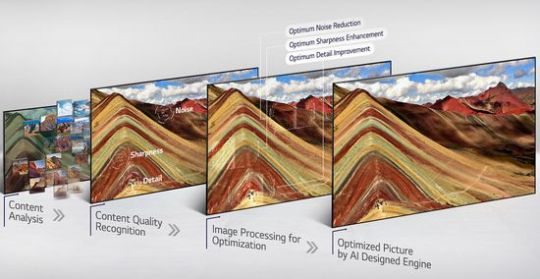
Conclusions
Probably, experts will continue to argue about the reasonable limits of the screen resolution. But in any case, 8K AI upscaling provides improved quality for lower resolution content. In addition, technology has an added bonus. In particular, Deep Learning of neural networks provides continuous quality improvement due to the expansion of patterns base. Theoretically, the quality of 8K AI Upscaling will constantly improve, creating a paradoxical situation when the new TV works worse than the old model. But of course, the price remains one of the main criteria for the consumer when choosing. Today, this difference reaches several thousand dollars. But many consider it inadequately overpriced compared to the quality gain that provides the modern 8K AI Upscaling. Most likely, companies will continue to improve it performance, while lowering prices for 8K models. This video shows the capabilities of the Samsung 8K AI Upscaling Technology. Read the full article
#8KAIUpscaling#AIBrightness#AIDeepLearningalgorithm#AIPicturePro#AISoundPro#bicubicinterpolation#bilinearinterpolation#checkerboardrendering#DeepLearning#hyperacuity#MachineLearningSuperResolutiontechnology#MLSR#Samsung8KAIUpscaling#SamsungQ950TS#SonyAIUpscaling#supersampling#Vernieracuity
0 notes
Photo

Turn ordinary days into extraordinary discoveries. Bring out the emotion in every moment, and go beyond imagination. Samsung presents 2020 QLED 8K, the TV that changes everything. #QLED8K #Real8KResolution #8KAIUpscaling #OTS #Samsung
Find your nearest store: https://bit.ly/2Gbx9UO Rush to our nearest ABM #SamsungSmartPlaza
Our Locations: Whitefield - 8317477230 Peenya - 8317477231 Kathriguppe - 8317477229 Hebbagodi - 8317477228 Ramamurthy Nagar - 8317477225 Hoskote - 8317477233 Vijayanagar - 8317477232 Marathahalli - 6360754660 Electronic city - 8317477227 HRBR Layout - 9380906038
0 notes
Photo

Turn ordinary days into extraordinary discoveries. Bring out the emotion in every moment, and go beyond imagination. Samsung presents 2020 QLED 8K, the TV that changes everything. Buy now and get benefits Visit: https://bit.ly/38niXVQ or http://bit.ly/3hiHcZC Call:9384841473 #QLED8K #Real8KResolution #8KAIUpscaling #Samsunglatesttvmodels #homeappliances #householdappliances #calladyar9384841473 #consumerelectronics #electronicshop #electronicstore #electronicshowroomchennai #electronicshopadyar #samsungtv #besttv #brandedtelevision #smarttv #Television #TV #homeappliancestorenearme #homeapplianceshopnearme #homeapplianceshowroomnearme #TVOnlineshoppingsite #TVAccessories #FullHDTV #tvstoreinadyar #tvshopinadyar #tvshowroominadyar #tvstoreinchennai #tvshopatchennai #tvshowroomatchennai (at Chennai, India) https://www.instagram.com/p/CCfn5MLDk6f/?igshid=zt7883ad5f2e
#qled8k#real8kresolution#8kaiupscaling#samsunglatesttvmodels#homeappliances#householdappliances#calladyar9384841473#consumerelectronics#electronicshop#electronicstore#electronicshowroomchennai#electronicshopadyar#samsungtv#besttv#brandedtelevision#smarttv#television#tv#homeappliancestorenearme#homeapplianceshopnearme#homeapplianceshowroomnearme#tvonlineshoppingsite#tvaccessories#fullhdtv#tvstoreinadyar#tvshopinadyar#tvshowroominadyar#tvstoreinchennai#tvshopatchennai#tvshowroomatchennai
0 notes
Photo

Turn ordinary days into extraordinary discoveries. Bring out the emotion in every moment, and go beyond imagination. Samsung presents 2020 QLED 8K, the TV that changes everything. Buy now and get benefits Visit: https://bit.ly/38niXVQ or http://bit.ly/3hiHcZC #QLED8K #Real8KResolution #8KAIUpscaling #OTS #Samsunglatesttvmodels #homeappliances #householdappliances #calladyar9384841473 #consumerelectronics #electronicshop #electronicstore #electronicshowroomchennai #electronicshopadyar #samsungtv #brandedtelevision #smarttv #Television #TV #homeappliancestorenearme #homeapplianceshopnearme #homeapplianceshowroomnearme #TVOnlineshoppingsite #TVAccessories #FullHDTV #tvstoreinadyar #tvshopinadyar #tvshowroominadyar #tvstoreinchennai #tvshopatchennai #tvshowroomatchennai (at Chennai, India) https://www.instagram.com/p/CCFjn1mjFtZ/?igshid=1m4pgqs3s6c84
#qled8k#real8kresolution#8kaiupscaling#ots#samsunglatesttvmodels#homeappliances#householdappliances#calladyar9384841473#consumerelectronics#electronicshop#electronicstore#electronicshowroomchennai#electronicshopadyar#samsungtv#brandedtelevision#smarttv#television#tv#homeappliancestorenearme#homeapplianceshopnearme#homeapplianceshowroomnearme#tvonlineshoppingsite#tvaccessories#fullhdtv#tvstoreinadyar#tvshopinadyar#tvshowroominadyar#tvstoreinchennai#tvshopatchennai#tvshowroomatchennai
0 notes
Text
What TV resolution do we need?

As usual, CES 2020 clearly demonstrated the main focus areas of companies' efforts to improve TVs. In fact, they cover almost all aspects, including design, audio quality, enhanced functionality, etc. But, improving image quality remains one of the main directions. Today, companies solve this problem using a variety of methods, including: - increasing resolution; - increased efficiency of AI 8K Upscaling; - improving color rendering by improving the backlight; - automatic calibration. TCL demonstrated the 8th series with Mini LED backlight Technology and announced its next generation called Vidrian Mini LED.

Today, this Chinese company is confidently leading the way in improving FALD (full-array local dimming) technology. According to many experts, Mini LED backlight or, already, Vidrian Mini LED Technology will be able to closely approximate the color accuracy of LED TVs to OLED technology. In addition, this year, almost all companies introduced new auto-calibration modes. In particular, Sony developed Ambient Optimization, new Samsung TVs use Adaptive Picture, Adaptive Peak Brightness and Adaptive Tone Mapping, LG TVs have Dolby Vision IQ. But an unprecedented number of 8K models from almost all leading companies demonstrates the dominance of the trend of increasing TV resolution.
Introduction
Disputes over the avalanche spread of 4K are still ongoing, but almost all leading companies already offer 8K TVs. Basically, skeptics of this trend use two fairly convincing arguments. First, many have not forgotten the relatively recent history of 3D TVs. The rapid growth of its popularity began after a demonstration at CES and IFA in 2010. Many experts quite logically predicted its excellent prospects. Of course, the manufacturers adequately responded to demand, significantly improving and cheapening this technology in its models. Unfortunately, the high cost of producing 3D content has become an insurmountable obstacle to its further development. As a result, almost all companies abandoned 3D support in their TVs. Therefore, today experts quite reasonably express doubts regarding the prospects for the production of native 8K content, which today is practically absent. Probably for this reason, companies are actively improving 8K AI Upscaling technology. In the worst case, these TVs will be able to improve quality playback of lower resolution content.

Secondly, they quite reasonably ask about the advisability of increasing resolution in terms of eye capabilities. The screen resolution of smartphones confirms these doubts. As known, many modern smartphones already provide 400, 500 ppi and higher. But according to many ophthalmologists, 600 ppi is close to the limit of perception for our vision. Accordingly, a further increase in resolution does not make much sense. In the same time, many companies continue to increase it. Today, the absolute record belongs to the Sony Xperia Z5 with 806 ppi.

This value corresponds to 4K, but does not make sense due to the limited possibilities of our eye. But this argument has some additional aspects.
Vernier acuity (hyperacuity)
As know, standard measure of visual acuity using Snellen eyechart. The argument of skeptics is based on the limitation of visual acuity, which does not distinguish between 8K vs 4K due to too high pixel density. In particular, its lower limit does not exceed 20/20.

But the Japanese NHK broadcaster did some interesting research to find out the effect of resolution on perception. Of course, visual acuity remains a major factor, but it's not the only one. Brain and Vernier acuity (hyperacuity) also significantly affect image perception. For example, many people will be able to distinguish the difference between two pairs of lines, one of which contains perfectly parallel lines, and the second includes lines with an offset of only one pixel. In this case, Vernier acuity will take this displacement as a stepping stone.

But the spacing the pixels on the 8K screen is half vs 4K matrix. Accordingly, reducing the height of the step increases the smoothness of the lines and we perceive the 8K image as clearer. Moreover, the brain reinforces this difference by trying to create a more analog-like image, increasing its realism. Thus, the argument based on only traditional visual acuity is not convincing enough.
Experiment Results
Moreover, recent studies of Dr. YungKyong Park of Ewha Womans University in Seoul further supports this hypothesis. In this experiment, scientists installed side-by-side 65-inch TVs with 4K and 8K resolution, which were calibrated at 500 nits of peak luminance. Of course, all 120 participants in the experiment had the same 20/20 visual acuity and normal color vision. The experiment was conducted at a distance of 9 feet from the displays in a dark room. Content included the 16 images and 3 videos with visuals. As a result, almost all participants in the experiment noted the difference 8K vs 4K displays.

Interestingly, the participants in the experiment noted not increased sharpness or contrast of the image due to higher resolution. According to them, 8K images looked cooler, warmer, more delicious, heavier, etc, which corresponds to sensory perception. In addition, Dr. Kyoung-Min Lee of Seoul National University investigated 8K resolution in terms of its perception by the brain. As known, increasing resolution reduces information loss. Accordingly, the dynamic signal-to-noise ratio increases. As a result, the level of immersive effect also rises. Thus, the brain is less tired when perceiving 8K content. At the same time, watching provides richer emotions due to high realism of the perceived content.
Conclusions
1. In the absence of native 8K content, 8K TVs will be able to improve quality playback of lower resolution content with 8K AI Upscaling technology. 2. Today, the screen of 75" 8K TV provides up to 120 ppi. But according to ophthalmologists, the eye can perceive up to 600 ppi due to Vernier acuity (hyperacuity). In this case, the brain distinguishes images with different detailing even if they are not visualized. Therefore, increasing the TV resolution will be relevant in the coming years. In fact, increasing resolution reduces information loss. Accordingly, the dynamic signal-to-noise ratio increases. As a result, the process requires less brain effort to interpolate the lost data. In other words, the brain is less tired when perceiving content in high resolution. In addition, the level of immersive effect also rises due to high realism of the perceived content. Thus, higher detail reduces the load on the brain, while increasing the immersive effect. 3. Given these factors, increasing ppi of the TV screen by increasing the number of pixels has good prospects and to continue to be one of the main ways to improve image quality. This video demonstrates the capabilities of the 8K AI Upscaling in the Samsung Q950TS 8K at CES 2020. Read the full article
#8KAIUpscaling#8KTVs#hyperacuity#LGDolbyVisionIQ#SamsungAdaptivePicture#SonyAmbientOptimization#TVresolution#Vernieracuity#VidrianMiniLEDtechnology
0 notes
Text
Samsung Q950TS 8K Review
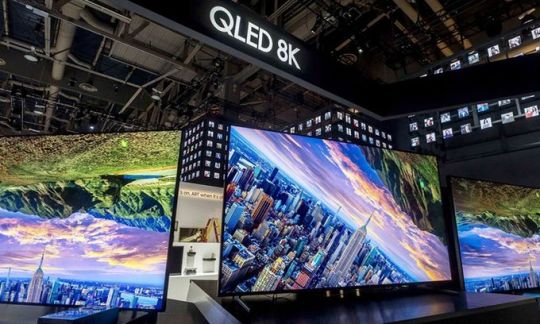
As known, these days companies present their new products at CES 2020. As usual, the attention of experts is primarily attracted by the leaders of the consumer electronics segment, which shape development trends. Of course, Samsung is one of them. The company fully met expectations by presenting three new TVs, including the second generation of Samsung 8K model, innovative MicroLED panels and the experimental The Sero TV with a rotary screen for viewing video content in vertical format, for example, from Instagram. Of course, Samsung Q950TS aroused the greatest interest among experts. In fact, the company created the second generation of its 8K TV. Today this model is one of the brightest among modern TVs. Its peak brightness reaches 4000 nits. The Q950TS uses a FALD (full array local dimming) with about 500 dimming zones. TV analyses a map of current image, defining bright or dark areas. Samsung engineers demonstrated German pedantry, harmoniously improving almost all components, including design, processor, video processing algorithms, sound, modes and functions, etc.
Design
The company has taken the next step in implementing the bezel-less design concept, which it calls Infinity Design TV.
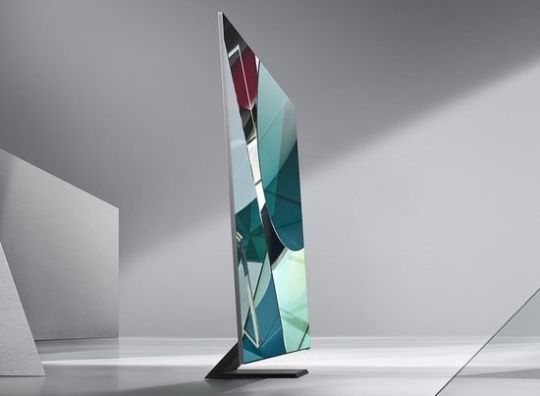
This TV has just a tiny 2mm-wide border around the top and side edgesand slightly wider border at the bottom with Samsung logo. As a result, engineers achieved an excellent result by providing a screen-to-body ratio of nearly 99%. In addition, the bezel-less design creates a stunning effect of presence by lowering the visualization of the border between the screen and its surroundings. But it is maximally perceived when watching from 10-15 ft. The 15 mm panel thickness is perfectly suitable for wall mounting, with the No Gap bracket. In this case, the screen can be connected with a single fiber cable.

A few years ago, Philips Electronics developed and patented Ambient Lighting technology.
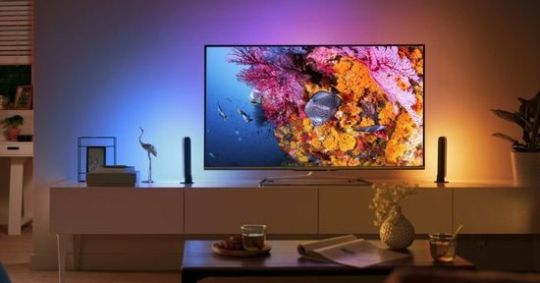
The idea was liked by many consumers and quickly became popular. In 2018, Samsung proposed their own idea by creating Ambient Mode.
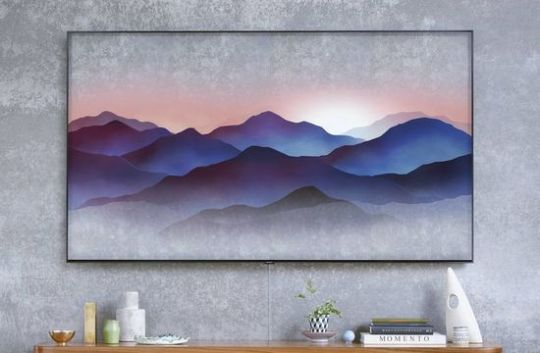
When the TV is off, Ambient Mode displays a stylish screensaver or family photo. In 2019, Samsung significantly improved it, expanding the range with images from the Internet. In addition, the company added new color filters, settings for background tones and brightness, animation, etc. This year, the company improved it with Bixby, Samsung’s AI assistant. For example, a TV can create a relaxing background on the screen by voice command. In fact, the TV performs in this mode the function of an intelligent element of the interior. To date, Samsung has announced the 65-inch, 75-inch and 85-inch versions.
Sound system
Of course, the perception of media content is significantly dependent on sound quality. Therefore, the company made very great efforts, seriously improving the sound system. Despite the ultra-thin design, South Korean engineers were able to place eight drivers in a six speaker array in the case. In fact, the Q950TS uses a 4.2.2-channel layout, which includes two speakers on each side, and a pair woofers in the back. The speakers are hidden behind a pattern of tiny holes in the outer edge of the TV body.
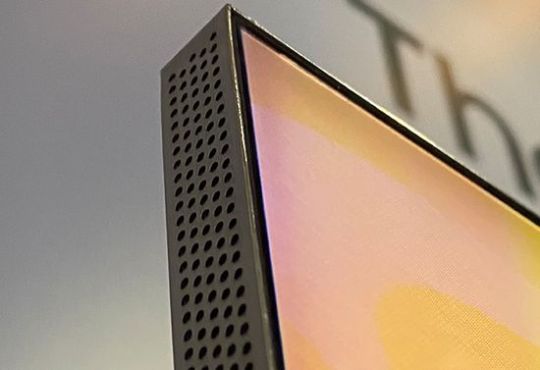
Mounted on a stand, the TV provides crisp and clear 5.1 channel surround. Unfortunately, the effectiveness of woofers with wall-mounting raises questions. The Q950TS has a sound optimization feature for first setup. In this mode, the TV generates and sends out test tones, receives reflected signals using built-in microphones and measures them. Then, it creates a room map to create an optimal soundstage. Unfortunately, the Q950TS does not support Dolby Atmos, but can send Atmos via ARC (audio return channel) from its internal apps.
Game mode
Almost all Samsung TVs of recent years are perfectly adapted for games. Q950TS was no exception. Of course, the Q950TS supports VRR (variable refresh rate) and ALLM (Auto Low Latency Mode). In addition, the new TV also supports AMD FreeSync, which provides, for example, DisplayPort Adaptive-Sync. Today it is an ideal solution for smooth gameplay with decreased lag and virtually no tearing. Moreover, the company claims no more than 10 ms input lag in Auto Game Samsung mode. The Multi-View option is also convenient for side-by-side viewing the game videos. In addition, the TV has a new surround mode with additional settings for sound effects in games. Also, Samsung has enhanced the Game Motion Plus feature. According to the company, the smooth playback in games has increased by 40%.
Q950TS features
1. Quantum Processor 8K provides more efficient AI upscaling, using machine learning algorithms to process data for each pixel. In addition, it generates image elements when restoring the original 8K content.
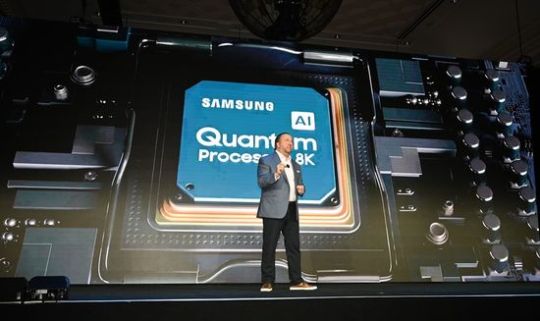
2. The new Adaptive Picture function automatically adjusts brightness and contrast depending on the ambient light.
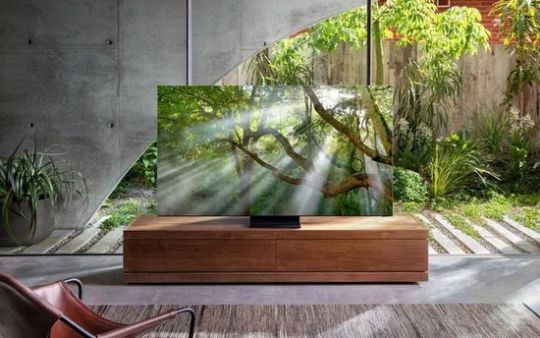
3. AI ScaleNet technology reduces data loss during video streaming. AI ScaleNet compresses the content during transmission from the provider, and then restores it to the TV. Thereby, the new technology halves the bandwidth requirements. According to Samsung, it will continue to actively improve this technology, considering it very promising. In particular, the company has agreed with Amazon Prime Video to jointly test the AI ScaleNet. 4. TV uses eight drivers, providing a 4.2.2-channel layout and OTS+ (Object Tracking Sound Plus) technology by analogy with Dolby Atmos and DTS: X. Their combination provides a stunning dynamic soundscape. 5.Active Voice Amplifier (AVA) adjusts the volume of dialogs depending on the noise level. For example, the noise of a blender or a vacuum cleaner automatically activates the option. But AVA activation during a loud conversation requires pressing a passive-aggressive button on the remote control. 6. Improved Universal Guide offers channels, content and services using AI-based algorithms. 7. Probably, Samsung Health with functions of a fitness organizer will appeal to supporters of a healthy lifestyle. In addition, it offers free and exclusive content from Calm, Echelon, FitPlan, Obe Fitness, Jillian Michaels, Barre 3, etc. 8. Multi-View projects the phone screen onto the TV screen in a separate window. The option has 14 different presets, including side-by-side viewing, picture-in-picture viewin, etc. 9. Digital Butler provides control of all IoT devices in the house using an infrared beam.
Conclusion
PROS - bezel-less Infinity Design; - high-quality 8K AI upscaling with AI Quantum Processor 8K; - impressive picture quality; - superior sonic performance with eight drivers (4.2.2-channel driver array); - incredibly low input lag up to 10 ms in Auto Game Samsung mode; - HDR support, including HDR10, HLG and HDR10+; - Deep Learning with neural network; - Ultra Viewing Angle; - Adaptive Picture, Adaptive Peak Brightness and Adaptive Tone Mapping; - Object Tracking Sound Plus (OTS+), Active Voice Amplifier and Q-Symphony; - AV1 (AOMedia Video 1) codec for 8K YouTube. CONS - today OTS+ is inferior to Atmos; - no Dolby Vision or Atmos support. Traditionally, Samsung has proven its claim to leadership by introducing the Q950TS with a wealth of innovative solutions. The Bezel-less Infinity Design concept is already close to ideal. Screen-to-body ratio has already reached nearly 99%. Eight drivers in a 15 mm case are amazing. Moreover, the company has demonstrated its successes in fundamental areas, including the development of 8K AI upscaling based on Deep Learning using a neural network and AI ScaleNet. Of course, the Q950TS is unlikely to become BestSeller due to the high price, but the flagships do not pursue this goal. First of all, they must confirm the leadership ambitions of the company. Apparently, the Samsung Q950TS 8K perfectly coped with this task. This model embodied almost all the latest Samsung's innovative technologies. Apparently, Samsung Q950TS 8K will compete with Nano99, Nano97 and Nano95 series of LG NanoCell 8K TVs and Sony Z8H 8K. This video offers an overview of the Samsung Q950TS 8K at CES 2020. Read the full article
#8KAIUpscaling#ActiveVoiceAmplifier#AdaptivePicture#AIScaleNet#AOMediaVideo1#AutoGameSamsungmode#AV1#DeepLearningwithneuralnetwork#DigitalButler#DisplayPortAdaptive-Sync#InfinityDesign#ObjectTrackingSoundPlus#QSymphony#QuantumProcessor8K#SamsungHealth#SamsungQ950TS8K#TheSeroTV
0 notes
Text
New technologies in Samsung TVs 2020 Review
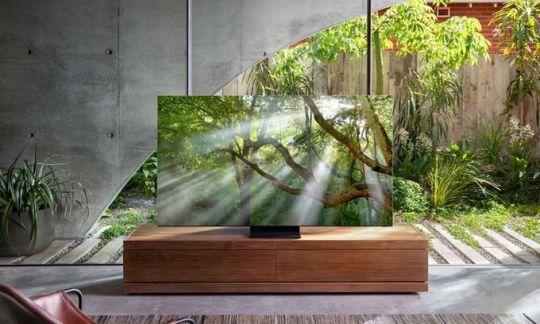
As known, these days companies present their new products at CES 2020. As usual, the attention of experts is primarily attracted by the leaders of the consumer electronics segment, which shape development trends. Of course, Samsung is one of them. The company fully met expectations by presenting three new TVs, including the second generation of Samsung 8K model, innovative MicroLED panels and the experimental The Sero TV. It has a rotary screen for viewing video content in vertical format, for example, from Instagram.
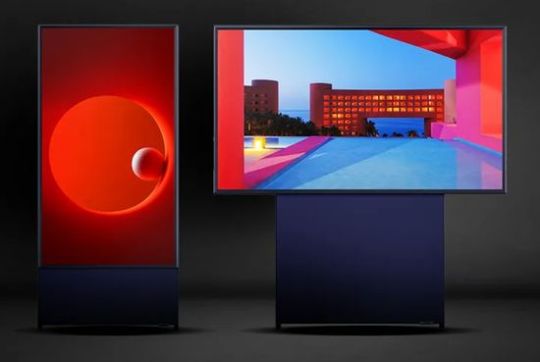
Of course, Samsung Q950TS aroused the greatest interest among experts. In fact, the company created the second generation of its 8K TV.
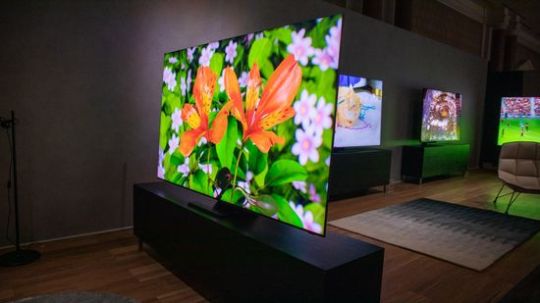
The company demonstrated that the past year was not in vain, embodying a huge number of innovative solutions in the Q950TS. Moreover, this model demonstrated the company's successes in fundamental directions, including 8K AI upscaling based on Deep Learning with neural network and AI ScaleNet technology.
Upscaling
As known, upscaling increases the number of pixels in the original signal to increase the image clarity on the TV screen. This problem arose about 10 years ago when TVs already provided Full HD (1920 x 1080) resolution, and television channels broadcast the signal in HD format (1280 x 720), or SD format (480p, 576i). Of course, this factor significantly reduced the advisability of buying an expensive Full HD TV. At the first stage, companies successfully solved this problem, showing in advertising or when selling a magnificent image of high-quality video with high resolution. But having bought such a TV, the consumer was quickly disappointed due to the low image quality of low-resolution video from normal traffic. Very quickly, the consumer market realized that even a very expensive TV can provide high quality only when playing high-quality content. Of course, companies could wait for the required content to appear on the market, but there was a risk. For example, many people remember the rise and sunset of the 3D format in TVs. Even with a large number of fans, today almost all companies have abandoned this option due to the shortage of 3D video content. As a result, large companies, including Samsung, began to actively develop upscaling technologies for their models, reducing their commercial risks. Indeed, even in the absence of appropriate native content, upscaling provides at least an increase in the quality of available low-resolution content, stimulating the acquisition of expensive model. As a last resort, 8K TV with high-quality upscaling will improve the playback quality of accessible content.
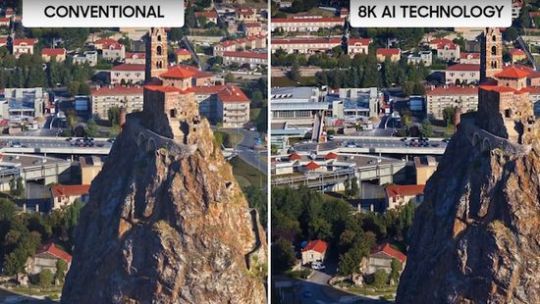
8K AI upscaling with AI Quantum Processor 8K
Physically, upscaling is similar to frame interpolation. As known, in this mode TV creates an additional intermediate frame based on two neighboring frames, ensuring smooth playback of even highly dynamic scenes. Accordingly, upscaling forms additional pixels to increase resolution. For example, the AI 8K Quantum easily scales content to 33,177,600 pixels. Unfortunately, upscaling can distort the original image, forming artifacts. Therefore, this task requires solving many complex problems, including color accuracy, GPU performance for video processing without lags, etc. As a result, companies developed a lot of upscaling technologies, including Pixel Shift (formation of an additional pixel by shifting), bicubic interpolation (calculation colors by adjacent pixels), etc. Today, AI upscaling is the most promising direction. The Q950TS confirms Samsung’s leadership in the AI upscaling.
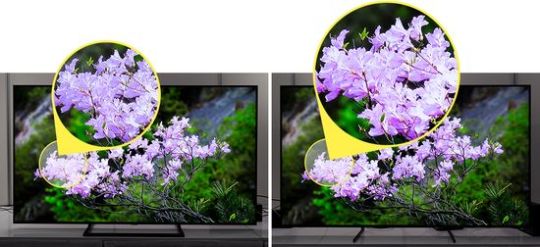
This model uses the latest generation of the AI Quantum Processor 8K, which extends AI upscaling capabilities. Previously, AI machine learning used a formula bank, which is downloaded to the TV and updated periodically. New Q950TS supports innovative Deep Learning using a neural network to expand machine learning. In fact, it creates its own formulas and algorithms without using a formula bank. Of course, Deep Learning has become a quality leap in AI processing. It is performed on a per-pixel basis with the use of noise reduction, restoration of contours, texture creation and restoration of small details. Deep Learning is primarily intended for small details and complex images.
AI ScaleNet
Of course, transmitting 8K streaming video content requires a significant increase in the bandwidth of communication channels, which depends on the speed of your Internet connection. To solve this problem, Samsung Research Visual Technology has developed a new AI ScaleNet video codec. As its name implies, the company uses AI to decompress 8K video. In fact, 8K is compressed to 4K using AI-downscaler and transmitted to the user's TV. Then, AI ScaleNet (codec with machine learning elements using different patterns for different image parts) restores 4K to 8K.
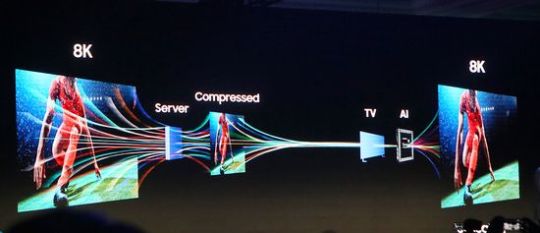
Kwang Pyo Choi, developer of this codec, said that AI ScaleNet uses AI Adaptive Bit Rate Streaming, which provides adjustment depending on the bandwidth of the networks. In fact, the codec adjusts the resolution for smooth video streaming. In prospect, this technology will provide the required quality of 8K content transfer even at low bandwidth, for example, during periods of heavy network traffic. Moreover, Samsung has agreed with Amazon Prime Video to jointly test the new technology. Additionally, the Q950TS supports Google's AV1 (AOMedia Video 1) codec for 8K YouTube content.
Object Tracking Sound Plus (OTS+), Active Voice Amplifier (AVA) and Q Symphony
Apparently, Samsung paid a lot of attention to the object-oriented audio, which lies at the heart of Dolby Atmos and DTS: X. As a result, the new TV has OTS+ (Object Tracking Sound Plus) technology that recognizes moving object inside the scene. After identifying the object, OTS+ moves the corresponding sound track in the direction of its movement using internal speakers. As a result, the sound follows the object. This effect works well, for example, in the scene of a passing car or flying helicopter. TV sequentially switches the speakers, creating a wonderful illusion of the engine sound that moves with the car or helicopter. Maybe Object Tracking Sound Plus is not yet ready to compete with Dolby Atmos, but, of course, it significantly surpasses the traditional 10W down-firing speakers in other flagships. In addition, the company offers AVA (Active Voice Amplifier) feature that adjusts the volume of dialogs depending on the noise level in the room. For example, when using a blender or vacuum, AVA will automatically increase the volume. But in case of a conversation in the room, the AVA activation requires pressing a passive-aggressive button on the remote control. Most likely, Q-Symphony technology will appeal to home theater enthusiasts. It combines the speakers in the Samsung TVs of 2020 and Samsung Q800T soundbars into a single audio system, creating a stunning dynamic soundscape. In fact, Q-Symphony creates a 9.1.4 configuration.
Conclusion
Samsung has once again confirmed its innovative leadership. New Samsung Q950TS 8K TV, innovative MicroLED panels and the experimental The Sero TV demonstrated that the company's engineers were able to make significant progress in a year. The Q950TS 8K TV has embodied almost all of the company's innovative solutions, including 8K AI upscaling with AI Quantum Processor 8K, AI ScaleNet, Object Tracking Sound Plus (OTS+), Active Voice Amplifier (AVA) and Q Symphony. In fact, Q950TS became the best advertisement of the innovative successes of a South Korean company. Apparently, Samsung Q950TS 8K will compete with Nano99, Nano97 and Nano95 series of LG NanoCell 8K TVs and Sony Z8H 8K. The video offers a demo of the Q950TS 8K and Sero Vertical TV at CES 2020. Read the full article
#8KAIUpscaling#ActiveVoiceAmplifier#AIQuantumProcessor8K#AIScaleNet#AOMediaVideo1#AV1codec#bicubicinterpolation#DeepLearningwithneuralnetwork#ObjectTrackingSoundPlus#PixelShift#QSymphony#SamsungQ950TS8K
0 notes
Text
Review of the Samsung Q900R 8K TVs
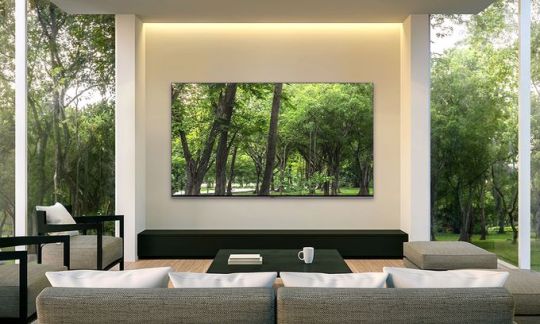
For decades, competition stimulates innovative boom in the consumer electronics segment, including high-tech TVs. HDR technology, HDMI 2.1 standard, 10 and 12-bit color depth, HFR (high frame rate) format, Micro LED, etc perfectly illustrate this trend. Increasing the resolution of TV matrices is one of the main directions. Today, Samsung rightly claims to be the leader in this segment. As known, in 2018, at the Samsung Forum, the company first introduced a series QLED 8K Q900R, including the QN65Q900RBFXZA, QN75Q900RBFXZA, QN82Q900RBFXZA, QN85Q900RBFXZA, and QN98Q900RBFXZA.

In 2019, Samsung expanded the series by announcing at IFA 2019 a new 55-inch QN55Q900RBFXZA QLED 8K model. Of course, some experts were skeptical of the 8K resolution for 55-inch TV. As known, engineers increase the screen resolution precisely to improve the quality of large images. For example, for TVs up to 50 inches most people are unlikely to feel the difference between HD and 4K resolution. But the relatively low price of just over $ 2,000 substantially reduces the significance of this argument. However, the cost of the rest of Samsung's 8K TV has also decreased. In the fall of 2019, it does not exceed $ 3,000, $ 5,000, and $ 6,000 for 65-inch, 75-inch, and 82-inch, respectively. For comparison, the 85-inch Sony XBR-85Z9G costs about $ 13,000. Today the 75-inch Samsung QN75Q900RBFXZA competes with 75-inch LG Nanocell 75SM9970 (75SM9900 in Europe) 8K, which also costs about $ 5,000. But, of course, the comparing the even 82-inch Samsung QN82Q900RBFXZA for $ 6,000 with LG OLED 88 Z9 8K with a price of $ 30,000 is unlikely to be correct.
Samsung QN75Q900RBFXZA vs LG Nanocell 75SM9970
The competition between these two giants has been going on for many years. Their 8K models use different matrices. In particular, Samsung 8K uses VA (Vertical Alignment) panels, LG Nanocell has IPS (In-Plane Switching) LCD panel. Basically, IPS-matrix vs VA-matrix differs in black level and viewing angle. As known, IPS panels provide a very wide viewing angle, but only an average level of black and contrast. VA panels provide excellent black level and contrast, but a small viewing angle. But according to the company, it managed to dramatically expand the viewing angle in the Q900R series.
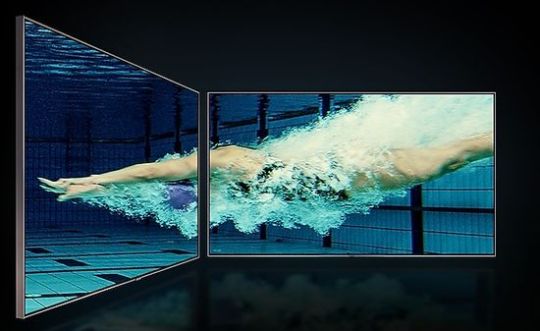
Today, LG produces OLED and Nanocell TVs. But LG's Nanocell technology is almost the same as Samsung's QLED technology. According to many experts, it was the company's marketing decision, because at that time Samsung had already patented QLED technology. In turn, operating principle of VA and IPS panels is radically different from OLED matrices. In particular, OLED matrices provide absolutely black (infinite contrast) with relatively low brightness from 500 to 1000 nits in top models. LED models are inferior in terms of black level, but significantly win in brightness (up to 1,500 nits), providing a fairly high contrast. Today, most experts note their features, including, for example, a sharper display of light areas and a magnificent Game mode with Input Lag only 15.4 ms for Samsung (for comparison, Input Lag of LG Nanocell 75SM9970 in Game mode reaches 43.6 ms). But in general, few of them give explicit preferences to any model. Therefore, the choice substantially depends on additional factors such as warranty, terms of delivery, etc or individual preferences (for example, design, browser, audio, etc).
Key Features
Models of Q900R series use the popular innovative Ambient Mode. In this mode, the TV displays a screen saver, for example, with a photo or picture.
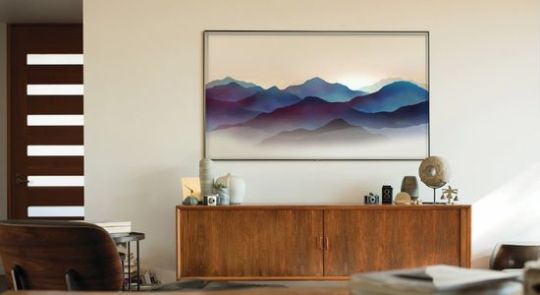
Moreover, a smartphone can provide a background image. This option requires only a photo of the TV on the wall through the app on the smartphone.

Ambient Mode uses a motion sensor that turns off the screen in an empty room. In turn, the light sensor adjusts the display brightness, providing the desired brightness regardless of the ambient light. Additionally, the TV automatically activates the "Game Mode" in the case of connecting the console. In this mode, the Input Lag is reduced to 15.4 ms, compared to 112 ms in normal mode. Moreover, the TV optimizes color display settings and contrast. Intelligent Mode automatically adjusts the picture brightness according to the ambient light.
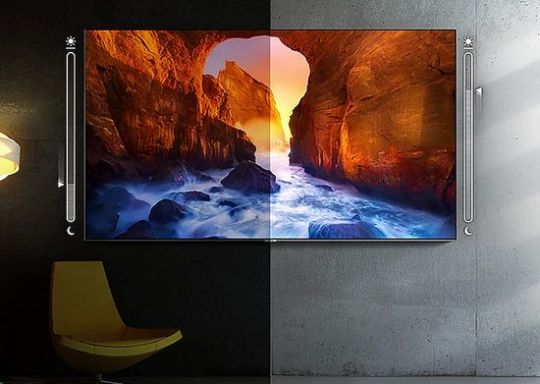
Quantum HDR 24X provides intensely deep colors and super-fine details with high clarity.
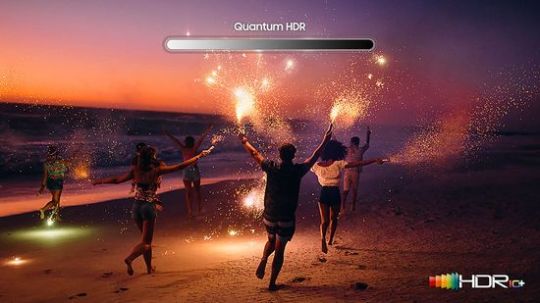
Quantum Processor 8K provides high-quality 8K AI Upscaling.
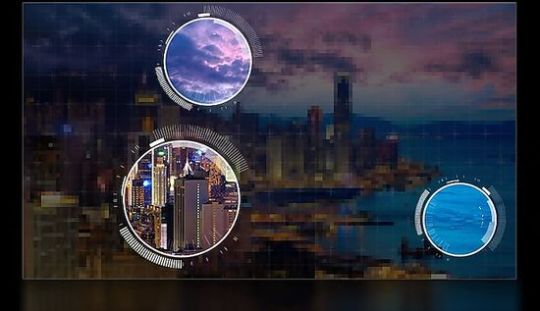
Samsung QLED 8K TVs support 100% Color Volume in the DCI-P3 color space and use FALD (Full Array Local Dimming). All models support HDR10, HDR10+, and HLG standards.
Conclusion
Pros - exellent image quality; - 8k resolution; - a significant reduction in prices; - High Refresh Rate; - high-quality 8K AI Upscaling; - exellent Game Mode with only 15.4 ms; - Ambient Mode; - very wide viewing angles for a VA panel; - 8K FPS via HDMI; - Bluetooth Audio Playback; - great local dimming and dark room performance. Cons - very limited 8K content; - no 3D; - "dirty" screen artifacts; - do not support Dolby Vision and Dolby Atmos; - no Advanced HDR by Technicolor; - no IMAX Enhanced; - do not support AMD Freesync; - no 4K HFR and 2K HFR; Of course, the appropriateness of buying expensive innovative models is always a dubious choice for many consumers. On the one hand, over the next few years, the processors of 8K models will mainly scale Full HD and 4K formats to 8K due to a shortage of 8K content. However, some factors in the 8K-TV segment are encouraging. On the other hand, 8K TVs are already available to many fans of innovative devices with a good budget. But fierce competition could well contribute to lower prices in this segment in the near future. A significant price reduction and a wide range of models (6 vs 2 models) allowed Samsung to get ahead of its traditional competitor LG. This video offers review of the latest 55-inch Samsung 8K QLED TV. Read the full article
#8KAIUpscaling#AmbientMode#LGNanocell75SM9900#LGNanocell75SM9970#QuantumProcessor8K#Samsung8KTVs#SamsungQ900R#SamsungQN55Q900RBFXZA#SamsungQN65Q900RBFXZA#SamsungQN75Q900RBFXZA#SamsungQN82Q900RBFXZA#SamsungQN85Q900RBFXZA#SamsungQN98Q900RBFXZA
0 notes
Video
Details of old memories come to life in 8K. Samsung presents 2020 QLED 8K, the TV that changes everything. Find out more at: https://bit.ly/38niXVQ #QLED8K #8KAIupscaling #Samsungtv #tvshowroomatchennai #tvstoreinchennai #tvshopinadyar #TVForfamily #tvstoreinadyar #tvshowroominadyar #tvshopatchennai #homeappliancesstorenearme #homeappliancesshopadyar #homeappliancesshowroomnearme #tvstoreatchennai #homeapplianceshopnearme #householdapplianceshopadyar #householdappliancestoreadyar #householdappliancesshowroomatadyar #consumerdevices #ConsumerElectronics2020 #consumerelectronicshopadyar #consumerelectronicsshop #consumerelectronics2020store #consumerelectronicsstore #qled8kshop #qled8kstore #qled8ktv #qled8ksamsung #qled8ktv2020 #buyqled8ktvatbestprice (at Chennai, India) https://www.instagram.com/p/CDDuM4LjoQ6/?igshid=17bd0myyymlm5
#qled8k#8kaiupscaling#samsungtv#tvshowroomatchennai#tvstoreinchennai#tvshopinadyar#tvforfamily#tvstoreinadyar#tvshowroominadyar#tvshopatchennai#homeappliancesstorenearme#homeappliancesshopadyar#homeappliancesshowroomnearme#tvstoreatchennai#homeapplianceshopnearme#householdapplianceshopadyar#householdappliancestoreadyar#householdappliancesshowroomatadyar#consumerdevices#consumerelectronics2020#consumerelectronicshopadyar#consumerelectronicsshop#consumerelectronics2020store#consumerelectronicsstore#qled8kshop#qled8kstore#qled8ktv#qled8ksamsung#qled8ktv2020#buyqled8ktvatbestprice
0 notes
Video
Samsung | 2020 QLED 8K: Official Launch Film – Hero When your TV can turn picture into 8K and has a borderless Infinity Screen, you have the TV that changes everything. Introducing the 2020 Samsung QLED 8K. Buy now and get benefits Visit: https://bit.ly/38niXVQ or http://bit.ly/3hiHcZC #QLED8K #Real8KResolution #8KAIUpscaling #OTS #Samsung #Samsunglatesttvmodels #homeappliances #householdappliances #calladyar9384841473 #consumerelectronics #electronicshop #electronicstore #electronicshowroomchennai #electronicshopadyar #samsungtv #besttv #brandedtelevision #smarttv #Television #TV #homeappliancestorenearme #homeapplianceshopnearme #homeapplianceshowroomnearme #TVOnlineshoppingsite #TVAccessories #FullHDTV #tvstoreinadyar #tvshopinadyar #tvshowroominadyar #tvstoreinchennai (at Chennai, India) https://www.instagram.com/p/CCNtNuajhuW/?igshid=1a5jd2aodledc
#qled8k#real8kresolution#8kaiupscaling#ots#samsung#samsunglatesttvmodels#homeappliances#householdappliances#calladyar9384841473#consumerelectronics#electronicshop#electronicstore#electronicshowroomchennai#electronicshopadyar#samsungtv#besttv#brandedtelevision#smarttv#television#tv#homeappliancestorenearme#homeapplianceshopnearme#homeapplianceshowroomnearme#tvonlineshoppingsite#tvaccessories#fullhdtv#tvstoreinadyar#tvshopinadyar#tvshowroominadyar#tvstoreinchennai
0 notes
Text
Samsung TVs 2020 Review
As known, these days companies present their new products at CES 2020. As usual, the attention of experts is primarily attracted by the leaders of the consumer electronics segment, which shape development trends. Of course, Samsung is one of them. The company fully met expectations by presenting three new TVs, including the second generation of Samsung 8K model, innovative MicroLED panels and the experimental ‘The Sero’ TV with a rotary screen for viewing video content in vertical format, for example, from Instagram.
Samsung MicroLED TVs
As known, Micro LED is an innovative technology of self-emitting display, and can be positioned as an analogue of OLED technology. Today, Samsung dominates in this direction. At ISE 2018 the company first introduced the modular large-format The Wall Professional Micro LED display in 146- or 219-inch versions with brightness up to 2000 nits. Then, at CES 2019, Samsung introduced a more compact 75-inch 4K MicroLED TV. In the summer of 2019, the company announced a new The Wall Luxury MicroLED TV with a diagonal of 292 inches (almost 7.5 meters), support for 8K resolution and with a brightness of up to 2000 nits. This year, the company announced 88- and 150-inch bezel-less MicroLED TVs with custom settings. According to the company, their brightness reaches an unprecedented 5,000 nits. For comparison, the brightness of modern OLED TVs does not exceed 1000 nits. Thus, today the list of diagonals Samsung MicroLED The Wall series includes 75, 88, 93, 110, 146, 150, 219 and 292 inches. Of course, the modular design provides excellent prospects for this technology. Over time, it will allow the user to create TV with a screen of any shape and size, including non-traditional formats. In addition, Samsung MicroLED TV optimizes video content for any screen, increasing its resolution at a constant pixel density. Moreover, MicroLED screens support any aspect ratio without compromising image quality. At CES 2019, the company demonstrated MicroLED modules and their assembly using brackets that are attached to the screen with sufficiently powerful magnets. The diagonal of one module does not exceed 13 inches.
The Sero TV
The company also did not ignore the growing popularity of the use of smartphones for shooting and viewing video content. According to research, 70% of millennials don't turn their phone horizontally to watch videos. As a result, the company's management decided to develop a vertical OLED TV targeted at the millennials and Generation Z. In 2019, Samsung announced the unconventional Sero Vertical TV. At CES 2020, the company introduced the 43-inch 4K Sero model. Thanks to a special stand, the display rotates from landscape mode to portrait mode for comfortable playback of video content from Instagram, Snapchat, etc. In addition, it can be synced with the phone via NFC to mirror the phone's display.
Samsung Q950TS 8K
Of course, Samsung Q950TS aroused the greatest interest among experts. In fact, the company created the second generation of its 8K TV. As known, last year the company introduced the Q900R 8K series with a diagonal of 65, 75 , 82, 85 and 98 inches. The 75-inch model of this series competed with LG 8K Nanocell 75SM9970. These models belong to approximately the same class, and their cost reached $ 6,000 and $ 5,000, respectively. In addition, LG introduced the LG 8K OLED88Z9, but its cost is approaching $ 30,000. Traditionally, OLED screens have many pros, but their price increases dramatically with increasing screen sizes. Today 75-inch Q950TS with 8K (7680 × 4320) resolution is one of the brightest among modern TVs. Its peak brightness reaches 4000 nits. The Q950TS uses a FALD (full array local dimming). As known, today it most effectively provides deep black gradations and brighter highlights with minimal blooming or haloing. Tentatively, the number of zones does not exceed 500. In addition, the company increased performance with Adaptive Peak Brightness. TV analyses a map of current image, defining bright or dark areas. Based on the analysis, it increases current for brighter areas and decreases - for darker parts. Other improvements require more detailed analysis. Samsung engineers demonstrated German pedantry, harmoniously improving almost all components, including design, processor, video processing algorithms, sound, modes and functions, etc. As a result, Q950TS embodied a huge number of innovative solutions. Moreover, this model demonstrated the company's successes in fundamental directions, including 8K AI upscaling based on Deep Learning with neural network and AI ScaleNet technology.
Conclusion
PROS - bezel-less Infinity Design; - high-quality 8K AI upscaling with AI Quantum Processor 8K; - impressive picture quality; - superior sonic performance with eight drivers (4.2.2-channel driver array); - incredibly low input lag up to 10 ms in Auto Game Samsung mode; - HDR support, including HDR10, HLG and HDR10+; - Deep Learning with neural network; - Ultra Viewing Angle; - Adaptive Picture, Adaptive Peak Brightness and Adaptive Tone Mapping; - Object Tracking Sound Plus (OTS+), Active Voice Amplifier and Q-Symphony; - AV1 (AOMedia Video1) codec for 8K YouTube. CONS - today OTS+ is inferior to Atmos; - no Dolby Vision or Atmos support. In general, the company has confirmed its status as one of the innovative leaders by introducing promising high-tech MicroLED TVs, experimental Sero TV and the magnificent Q950TS with a huge number of innovative solutions. Of course, the Q950TS will have to compete with LG NanoCell 8K TVs, which, like last year, includes the Signature OLED 8K and NanoCell 8K. Given the approximate price, the Q950TS and LG NanoCell 8K are likely to be in the same price segment. But regardless of the results of their rivalry, the real quality of the 8K AI upscaling based on Deep Learning with neural network and AI ScaleNet will be very interesting to users and experts. This video offers an overview of the Samsung Sero Vertical TV at CES 2020. Read the full article
#8KAIUpscaling#ActiveVoiceAmplifier#AdaptivePeakBrightness#AdaptivePicture#AdaptiveToneMapping#AIQuantumProcessor8K#AIScaleNet#AutoGameSamsungmode#AV1codec#DeepLearning#ObjectTrackingSoundPlus#OTS+#QSymphony#SamsungMicroLEDTVs#SamsungQ950TS8K#SamsungTVs2020#SeroTV#SeroVerticalTV
0 notes